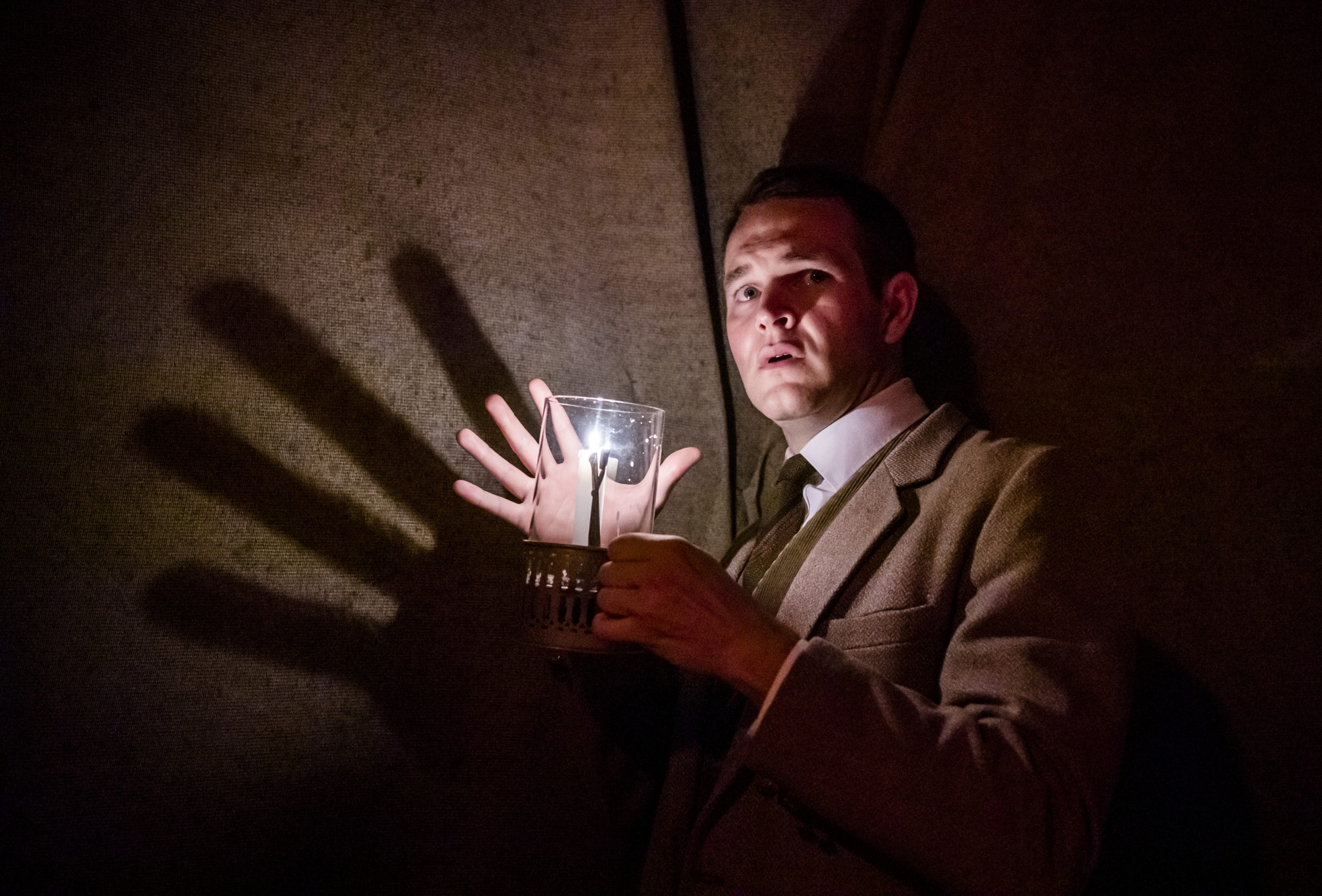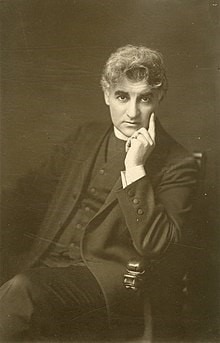The Woman in Black, the long-playing London ghost story now perturbing a Shakespeare Theatre Company stage, reminds us that spine-chilling horror can be the most delightful of sensations. To put us in the mood for this deliciously spooky production, I scoured the world (well, the Internet) to find the most attractive and mysterious theatre ghosts. Let’s start (where else?) with Broadway.

1) David Belasco (1853-1931)
In 2005, Dracula star Melissa Errico and other actors heard an argument behind the portrait of this famed producer. When they checked, they discovered that no one was there.
A flamboyant director, playwright, and ladies’ man, Belasco was known as the “Bishop of Broadway” for his customary priestlike attire. He fostered the careers of Mary Pickford, Barbara Stanwyck, and James O’Neill, father of American playwright Eugene O’Neill. Belasco was noted more for his preference for a natural acting style, lavish settings, and elaborate special effects, than for his taste in plays.
The theatre that bears his name, the Belasco, opened as the Stuyvesant in 1907. It has been owned by the Shubert Organization since 1948. It was lavishly appointed, with a duplex above it where Belasco lived. Decorated like a Gothic church, his apartment contained collections of art, theatre memorabilia, and erotica. In 2010, the theatre was restored to its former glory. Next it will feature a musical reimagining the work of Bob Dylan, The Girl from the North Country, which will open soon following successful runs at the Public Theater, the Old Vic London, and the West End.
Belasco’s ghost is known for pinching the bottoms of young actresses. He is also said to appear backstage after a good show, greeting the actors. If he doesn’t like the production, he is rumored to ransack the dressing rooms.

Belasco’s ghost is a benevolent if mischievous figure, and encountering him would probably be a harmless experience. However, actresses, watch your backs!
2) Judy Garland (1922-1969)
While playing Belle on Broadway in Beauty and the Beast, Andrea McCardle saw a white-gowned cellist in the pit of the Palace Theatre in New York.
The Nederlanders’ Palace Theatre, which is currently closed, is being rebuilt by TSX and will open in 2022 as the newest and largest theatre in New York City. The Palace was built in 1913 in the neo-Classical style. From 1913 to 1929, it was the top vaudeville stage in the country, featuring stars like Ethel Barrymore (1913), Lillian Russell (1918) and the Marx Brothers (1920). It is said to contain over 100 ghosts. The most illustrious, most would agree, is Judy Garland.

Judy Garland, according to some, is still with us. Garland’s ghost is said to appear near a special entrance designed for her. A tightrope walker who was killed or seriously injured during a performance, Louis Borsalino, can sometimes be seen swinging from the rafters, screaming, and falling. A man in brown, a sad little girl, and a boy playing with toys are other apparitions.
3) John McCullough (1832-1885)
In September 1896, actor Frederic Bond was on stage preparing for a show when he spotted a spectral presence; his late friend John McCullough, costumed as Hamlet. He shouted McCullough’s name, and the ghost vanished.
McCullough is said to appear right here in DC, at the storied National Theatre, which opened in 1835 and features Broadway productions. Among the artists who have appeared there: Jenny Lind “The Swedish Nightingale,” and, more recently, Rita Moreno, James Earl Jones, Dame Judi Dench, and Sir Ian McKellen. The theatre is currently presenting Jersey Boys.
Although the story may be apocryphal, McCullough was a real person. He was a classically trained actor who specialized in Shakespeare. At the time of his death, the Tiber Creek ran right under the theatre. Actors often spent time there washing their costumes. One night McCullough and another actor were at the creek, getting ready for a performance. There was an argument; likely over an actress or a role, and the other actor shot McCullough and dumped him in the Tiber.

McCullough, who probably actually died of paralytic dementia in 1885, is blamed for breaking the ankle of Adrian Zmed during a Broadway production of Grease.
4) Joseph Grimaldi (1778-1837)
In 2014, actor Clive Carter was in his dressing room at the Theatre Royal, Drury Lane. He was getting ready to go on as Mr. Salt in Charlie and the Chocolate Factory. Another actor came in to chat. The conversation turned to the Drury Lane ghosts. While they were talking, the television suddenly began switching channels. Then it stopped. When they began discussing the ghosts again, it started all over.
A Regency-era comedian, Joseph Grimaldi is said to be one of the principal ghosts inhabiting Drury Lane, which is considered the most haunted theatre in the world, It is currently owned by Andrew Lloyd Webber’s LW Theatres and is known for producing musicals. Currently under renovation, it will re-open in 2020 with Disney’s Frozen.

Grimaldi was the most popular English entertainer of his day. He played the Clown in British harlequinades, at Drury Lane, Sadler’s Wells and Covent Garden. He has a reputation as a helpful spirit, guiding and encouraging nervous actors.
Another well-known Drury Lane ghost is an 18th-century character known as the “Man in Grey.” He appears in the upper circle in a riding cloak and hat and then disappears into the wall. His appearance is believed to bring luck.
5) Assorted Screaming Phantoms (Ageless)
Lest we be confined to the Western tradition, let me introduce you to the Huguan Huiguan Opera House in Beijing, a main performance site for the Beijing Opera. This world-famous opera house, currently being rebuilt, was originally erected in 1907. The theatre is colorful, beautifully restored, with a traditional stage. During World War II, housing for the poor was built there, in the process, disturbing an ancient burial ground. It is said that the wailing of the dead can be heard in the courtyard of the theatre. If you throw a stone, a voice will shout at you to stop.
Ghosts and theatre somehow seem to go together. Actors are sometimes superstitious, and every theatre has a ghost light which is turned on after everyone has left at night. Theoretically, it is there for safety; but who knows what danger lurks, that a simple ghost light can protect us from? Don’t miss the captivating ghost story The Woman in Black (reviewed by DCMTA’s David Siegel here) while it’s still in town at the Shakespeare Theatre Company.
The Woman in Black plays through December 22, 2019, at the Michael R. Klein Theatre (formerly the Lansburgh) – 450 7th Street NW, Washington, DC. For tickets, call the box office at 202-547-1122 or go online.
Special thanks to my colleague, John Stoltenberg, for the original idea for this article.
Shakespeare Theatre Company’s Colleen Kennedy provides more background on The Woman in Black and holiday ghost stories in the STC ASIDES.




